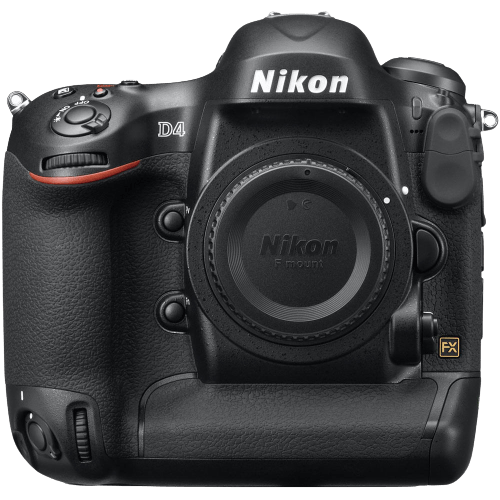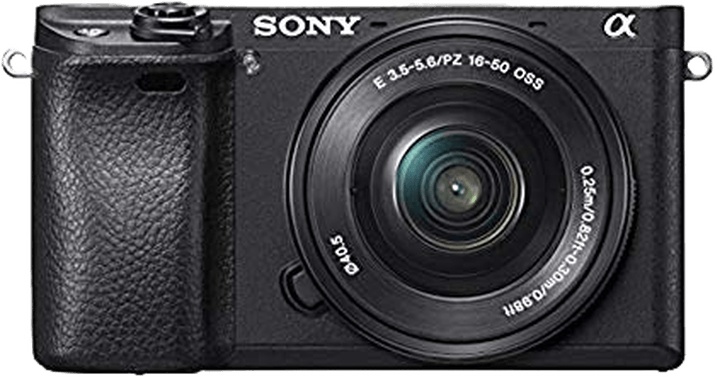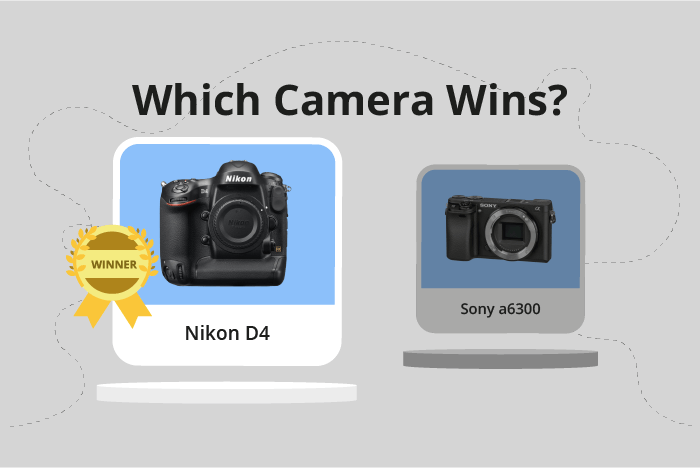Nikon D4 vs Sony a6300 Comparison
Nikon D4

Sony a6300

The Nikon D4, with a score of 63/100, narrowly edges out the Sony a6300, which scored 61/100. Both cameras were released in the 2010s, with the Nikon D4 in 2012 and the Sony a6300 in 2016. They differ in type, as the Nikon D4 is a DSLR while the Sony a6300 is a mirrorless camera.
The Nikon D4 stands out with its larger size (160 x 157 x 91mm) and heavier weight (1340g), which may offer better stability and durability. However, it comes with a hefty launch price of $5999. On the other hand, the Sony a6300 is more compact (120 x 67 x 49mm) and lightweight (404g), making it a more portable option. Additionally, its launch price is significantly lower at $1000.
Taking these factors into account, the Nikon D4 may be better suited for professional photographers who prioritize stability and durability, while the Sony a6300 is an attractive option for those seeking a more affordable and portable camera.
Nikon D4 vs Sony a6300 Overview and Optics
The Sony a6300 emerges as the winner in terms of optics, scoring 68/100, while the Nikon D4 lags behind with a score of 63/100. Both cameras share some common specifications, such as an 11 fps shooting speed, CMOS sensor type, and no image stabilization.
The Sony a6300 has an edge over the Nikon D4 with its higher megapixel count of 24.2 compared to the D4’s 16.2. This allows the a6300 to capture more detail and produce higher resolution images. Furthermore, the a6300 has a Bionz X processor, offering better image processing capabilities. The Sony E lens mount on the a6300 also provides access to a wide range of high-quality lenses.
On the other hand, the Nikon D4 outperforms the a6300 in terms of sensor quality, boasting a DXOMARK score of 89 compared to the a6300’s 85. This indicates better color depth, dynamic range, and low-light performance. The D4’s full-frame sensor size also contributes to its superior image quality and low-light performance. Additionally, the Nikon F lens mount is compatible with an extensive selection of lenses.
Although the Sony a6300 claims victory in the optics department, the Nikon D4 holds its ground with a superior sensor and lens compatibility. The a6300 is the better choice for those seeking higher resolution images and advanced image processing, while the Nikon D4 is more suitable for photographers who prioritize sensor quality and low-light performance. Both cameras have their strengths and would suit different photographers’ needs.
Nikon D4 vs Sony a6300 Video Performance
The Sony a6300 emerges as the superior camera regarding video capabilities, scoring 91/100, a significant 34-point lead over the Nikon D4, which scores 57/100. Both cameras share some video specifications, such as time-lapse functionality built in, allowing users to create stunning time-lapse videos with ease.
The Sony a6300 outperforms the Nikon D4 in several aspects, including higher video resolution and frame rate. With 4K video resolution and maximum dimensions of 3840 x 2160, the a6300 offers four times the resolution of the Nikon D4, which only provides Full HD with dimensions of 1920 x 1080. This difference results in the a6300 delivering crisper and more detailed videos. Additionally, the a6300 boasts a maximum video frame rate of 120fps, four times greater than the D4’s 30fps. This higher frame rate enables smoother slow-motion playback and improved motion capture.
The Nikon D4, while lacking in comparison to the a6300, still provides decent video quality with Full HD resolution and 30fps. For users primarily focused on photography with occasional video recording, the D4 might suffice. However, the Sony a6300 clearly surpasses it in terms of video capabilities.
Considering the significant differences in video specifications, the Sony a6300 is the superior choice for those prioritizing video quality and performance. The Nikon D4, although not as powerful in this aspect, may still be suitable for users with less demanding video requirements.
Nikon D4 vs Sony a6300 Features and Benefits
The Nikon D4 outperforms the Sony a6300 in features with a score of 57/100 compared to the Sony’s 54/100. Both cameras share some specifications, such as a 3-inch screen size, screen resolution of 921,600 dots, and the absence of a touchscreen and GPS.
The Nikon D4 excels in having a larger screen size of 3.2 inches, providing a better viewing experience for photographers. However, it lacks other modern features such as a flip screen, WiFi, and Bluetooth, which the Sony a6300 has.
On the other hand, the Sony a6300 offers a flip screen and WiFi connectivity, making it more versatile and user-friendly for various shooting situations and easy sharing of images. However, it does not have Bluetooth, and its screen size is slightly smaller at 3 inches.
While the Nikon D4 has a slight edge in the features score, it is essential to consider the specific needs and preferences of the photographer when choosing between the two cameras. The Nikon D4’s larger screen size is beneficial for those who prioritize a better viewing experience, while the Sony a6300’s flip screen and WiFi connectivity cater to photographers who require more flexibility and convenience in their shooting and sharing process.
Taking these factors into account, the Nikon D4’s higher score indicates its superiority in terms of features, although the Sony a6300’s additional capabilities may appeal to some photographers depending on their requirements.
Nikon D4 vs Sony a6300 Storage and Battery
The Nikon D4 outperforms the Sony a6300 in storage and battery with a score of 87/100, while the Sony a6300 scores 24/100. Both cameras lack USB charging capabilities.
The Nikon D4’s superiority stems from its two memory card slots, accepting Compact Flash and XQD cards. This provides more storage flexibility and backup options. Additionally, the D4 boasts an impressive battery life of 2600 shots per charge, using the EN-EL18 battery type.
On the other hand, the Sony a6300 has one memory card slot, compatible with SD, SDHC, and SDXC cards. Its battery life is significantly lower at 400 shots per charge, utilizing the NP-FW50 battery type.
Considering these factors, the Nikon D4 offers better storage and battery performance, while the Sony a6300 falls short in this comparison.
Nikon D4 vs Sony a6300 – Our Verdict
Are you still undecided about which camera is right for you? Have a look at these popular comparisons that feature the Nikon D4 or the Sony a6300:

